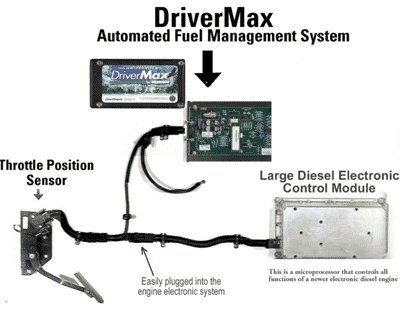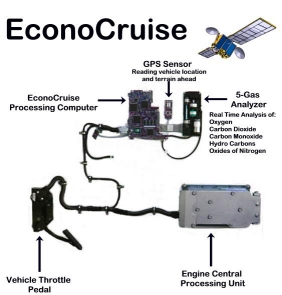Diesel Progress Magazine Covers Mirenco
Electronic Technology Designed to
Eliminate the "Lead Foot"
by Bill Siuru |
 |
As any fleet manager knows, different drivers can turn in significantly
different fuel economy results when operating the same vehicle. And over time,
no matter how well maintained, the fuel economy performance of a typical truck
or bus will go down as a vehicle ages.
In an effort to address both of these issues, Mirenco, Radcliffe, Iowa, has
developed a throttle management system called DriverMax that uses patented
technology to control the throttle in real-time and reduce or eliminate the fuel
waste caused by both imprecise driver throttle control and natural engine
degradation.

"One of the simplest and most over-looked solutions to a cleaner environment and
better fuel mileage is to simple take it easy on the vehicle throttle," said
Dwayne Fosseen, Mirenco’s founder, chairman and CEO. "DriverMax can be thought
of as a device attached to the driver’s foot, not and engine modification
device. It doesn’t do anything the driver’s foot can’t do, if the driver’s foot
were very smart and could consider the current level of deterioration of the
engine’s combustion process."
Originally conceived by Fosseen during the mid-1970s fuel crises, the technique
was subsequently engineered for commercial use under a joint development
agreement with the US Dept of Energy (DOE) Kansas City Plant (KCP). The DOE
developed a microprocessor-controlled fuel management system to monitor operator
input and vehicle fuel demand. Using these inputs, DriverMax controls the
optimum fuel flow rate via a throttle modulating system. Additionally, DOE
engineers designed the microprocessor to be affordable. While DriverMax is
initially being offered for heavy duty diesel engines, the patented technology
should be applicable to other vehicles including passenger cars with gasoline
engines in the future.
Mirenco is now beginning production of an electronic actuator that will enable
installation on mechanical engines. This allows the DriverMax computer to
control the operation of the fuel injection pump. It will allow the Mirenco
technology to be retrofitted to older mechanical diesel engines, including
off-road construction and mining equipment.
The DriverMax microprocessor is installed in the wiring between the throttle
position sensor and the electronic control module (ECU). Since DriverMax is
installed and operates completely outside the engine, installation can typically
be accomplished in less than an hour, the company said. Programming DriverMax
specifically for the vehicle takes only minutes using Mirenco’s DriverMax
software with a laptop PC connected to the unit. After a unit is installed,
DriverMax is designed to be easily reprogrammed to compensate for ongoing engine
wear.
In order to maximize the benefit of DriverMax, Mirenco technicians perform an
initial emission analysis on the engine using portable exhaust analyzers. Along
with emission analysis, the technicians may use an accelerometer to determine
vehicle performance on initial acceleration. DriverMax is then programmed
according the combustion state of the engine and the vehicle’s requirements for
power. Ongoing emission analysis can detect continued combustion degradation, in
which case minor DriverMax adjustments may be made.
Testing indicates that the DriverMax system can deliver fuel savings as high as
5 to 10 percent and smoke reduction of 50 percent or higher, the company said.
The Transit Authority of River City (TARC) in Louisville KY, installed DriverMax
on 100 buses and after a year of operation TARC estimated that is has eliminated
11,000 lb of emissions while saving 43,000 gal of fuel. According to J Barry
Barker, executive director of TARC, "The installation of DriverMax throttle
modulators on buses with five to eleven years of service is one of the
initiatives we are pursuing, and we are pleased with the results to date."
The units have also been installed on tour buses operated by Harvey
Transportation in the Grand Canyon National Park where they reduced particulate
emissions by an average of 74 percent from the engines’ previous PM levels. In
speed tests, the system has had a negligible impact on speed, typically less
than one second difference from zero to 40 mph, the company said.
Recently, Mirenco conducted an extensive series of tests designed to simulate an
enclosed working environment where heavy duty diesel vehicles are operated, such
as might occur in under-ground mines or warehouses, etc. Forty four
acceleration/deceleration cycles were performed over a 10 min. period and
particulate matter measures were continuously recorded at the PM 10 to 2.5
levels. The results consistently demonstrated a 74 percent reduction in PM 2.5
levels and a 76 percent reduction of PM 10, according to Mirenco.
Payback for the DriverMax system is typically six to nine months, the company
said. The system can be purchased direct from Mirenco, but a distributor network
is also being considered.
Mirenco also recently announced the next step in the application of its patents
in EconoCruise, which features satellite-to-throttle technology. As the name
implies, EconoCruise employs GPS to "learn" the topography of the roadway and
build a map of the route a vehicle travels. The system calculates and stores a
driver’s acceleration patterns along the given route, then when EconoCruise is
engaged along the same route in the future, speed and throttle control are
determined by the vehicle’s geographical location.

Follow-on versions of EconoCruise may employ a built-in database of topography
and terrain as well as real time emissions sensors, ambient conditions sensors
and relative wind calculations/adjustments, the company said.
The EconoCruise microprocessor can manage the throttle to meet the desired
performance criteria (e.g., best fuel economy, speed, and emissions tradeoff),
literally second-by-second via satellite, taking into account the topography and
terrain of the roadway, wind resistance, exhaust emissions, and engine
performance. EconeCruise, for example, allows the vehicle to gain an acceptable
and safe amount of momentum while traveling downhill or on a straightaway to
prepare for an uphill stretch of road ahead. This form of intelligent cruise
control allows less experienced drivers to achieve the same vehicle performance
as the better operators, the company said. When generating route data, the fleet
operator would use the best drivers who are familiar with both the route and the
particular truck, which could result in an optimum operational profile that
could be automatically replicated with any driver.
Like current cruise controls, the driver can override EconoCruise by tapping the
brakes or pressing the foot throttle. First successfully demonstrated in 1999,
the system is currently being refined under Mirenco’s second development
contract with the DOE. Production units are estimated to be available for heavy
duty trucks sometime in this quarter.
About Mirenco
Mirenco is a Radcliffe, Iowa-based Company that specializes in patented vehicle
management technology and consultative services for reducing vehicle emissions,
improving fuel economy and lengthening the service life of heavy-duty diesel
vehicles. More information is available at ble at www.mirenco.com, or via e-mail at
info@mirenco.com or by calling
800.423.9903.
Some of the statements made in this press release are forward-looking in
nature. Actual results may differ materially from those projected in
forward-looking statements. Additional information concerning Mirenco, Inc. can
be found within Mirenco's filings with the Securities and Exchange Commission.
Statements in this release should be evaluated in light of this additional
information.
Contact Information:
Dwayne Fosseen
fosseen@mirenco.com
800-423-9903
|